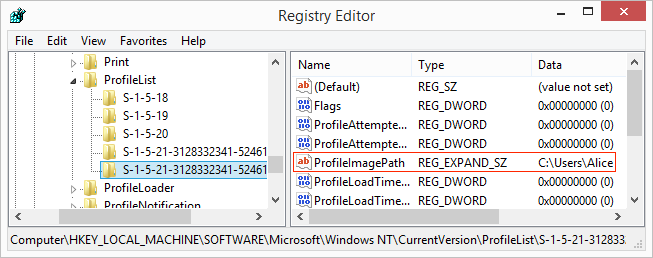Most guides, including Microsoft's own Renaming a User Account Does Not Automatically Change the Profile Path, only mention updating the value data for ProfileImagePath in the corresponding S-1-5... subkey of HKLM\SOFTWARE\Microsoft\Windows NT\CurrentVersion\ProfileList:
However, there are invariably many more references to the old path which need updating, especially since most guides (including Microsoft's) also fail to include step 6 above (symbolic links).
Or with a batch file or PowerShell script: Registry: find and replace part of a path in a batch file / PowerShell Registry Find and Replace
On a crufty, heavily-used system, removing all occurrences of C:\Users\Alice from the registry required using two additional batch search and replace tools, Registry Toolkit and Registry Replacer.
For longer usernames (e.g., AliceSmith), values containing the short path name (C:\Users\ALICES~1) may also be present and require updating.
If you ever decide to delete the symbolic link, be very careful: "If you have a symbolic link that is a directory (made with mklink /d) then using del will delete all of the files in the target directory (the directory that the link points to), rather than just the link. SOLUTION: rmdir on the other hand will only delete the directory link, not what the link points to."
From a comment by GuitarPicker: "[T]here may be some other programs which store the paths elsewhere, such as an .INI file, .XML file or a database."